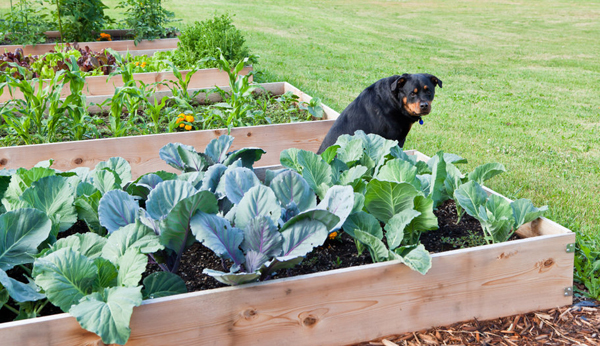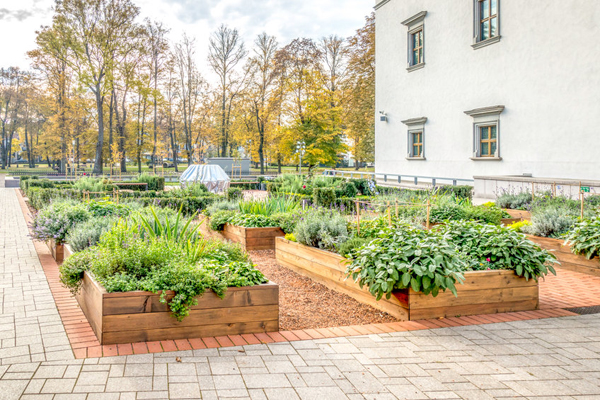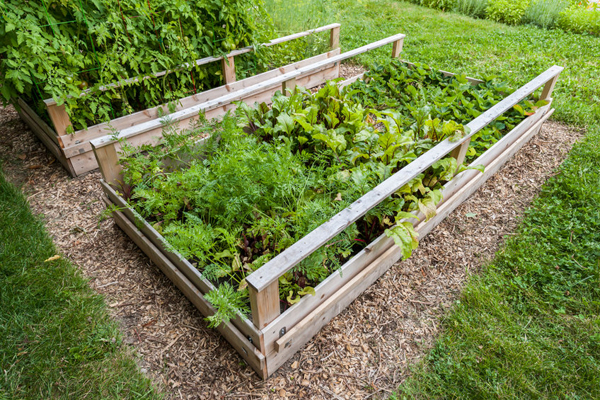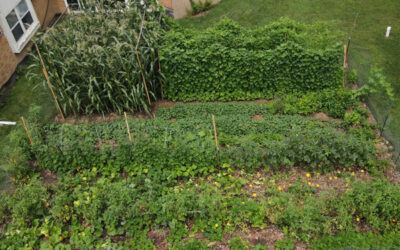I say: If we wanted to, we could grow enough food on our lawns to feed about 90% of our population.
You say: You’ve got to be kidding, right?
I say: Nope, I’m not. And the reason is that numbers don’t lie. See if you agree.
Start with the baseline data of what one garden can do
The foundational data point is what I’ve personally verified: that I can grow enough vegetables to feed myself for a year on a 35’ by 40’ plot of converted lawn. That’s with heavy clay soil and just six hours of direct sun per day, using only hand tools—for an average hour a day—and being 72. Also despite my yield rate of 0.7 pounds of veggies per square foot being only 60% of the average for self-sufficiency gardens. So, nothing unusual about my garden.
That’s not to say that absolutely everyone should or even can grow all their food in their yard. Rather, that the average yard-owner has the intrinsic capacity to do so, even with the not insignificant constraints I delt with. Nor is my experience an isolated achievement of just one garden. Half of Russia’s food is produced in household gardens on only 2-3% of its agricultural land. Another example (among others): Nigeria produces 50% of its vegetables on just 2% of its agricultural land. Point is, producing an abundance of home-grown food—including on a national scale, on very small amounts of land—is not unheard of.
But can we really feed ourselves on lawn gardens?
First, consider the existing capacity and inertia favoring home food production. Almost half (44%) of all U.S. households already have some kind of food garden, according to the National Gardening Association. Moreover, sales of readily available seed, garden, and food-preserving supplies have gone through the roof since 2019, likely spurred by the pandemic. So the critical human and physical infrastructure, as well as initial social momentum, are already in place; we’d just need to expand what 146 million people are already doing. Victory gardens—not only ours but also those of other countries—have already shown how quickly and easily that can be done.
Second, we already have a lot invested in our quite prodigious lawns, as indicated by the $50 billion we spend on them every year, and the fact that they’re the most irrigated crop in the U.S. So maybe it won’t come as too much of a surprise to learn that there’s more than enough lawn space to accommodate food gardens sufficient to feed almost everyone. Nevertheless, there are different ways of looking at it. Some involve a modest amount of data processing, so I’ve included a couple appendices for those who want to check out the math.

The Broad Stroke
We have about 43 million acres of lawn in the U.S. – enough for 1.4 billion gardens the size of mine. Given our population of 332 million, that means there are 0.13 acres of lawn per capita, enough to accommodate four gardens like mine for every person in the country.
However, not all lawn space is located next to homes, nor is it spread equitably among households and community gardens. Lawn space is occupied by national, state, and local parks; athletic facilities such as golf courses, soccer, and football fields; town squares; airports; and school and business campuses, as well as other areas not necessarily amenable to food gardening. Which explains why a closer look reveals less lawn space per person.
Households
There are some 130 million U.S. households, of which 80% (104 million) have lawns. The average size of those lawns is about 10,900 sq ft., which could accommodate 2.4 gardens like mine per household. That’s not to say that they necessarily do; the average U.S. food garden is only 20’ x 30’, or 600 sq ft. But regardless of current garden size, at an average of 2.6 persons per household there would be room for just a little less than one 1,400 sq ft plot like mine per person among those who have household gardens.
Of course, 20% of our households do not have lawns and thus lack gardens altogether, so they would have to use community gardens to grow their own food. Yet they would still be part of the urban area that has sufficient lawn area to accommodate the community version of food gardens. Describing just how that would happen is beyond the scope of this blog.
Urban versus rural
Of our population of 332 million, 83% (277 million) live in 106,000 square miles of urban areas, so that’s where most food gardens would have to be located. Surprisingly, 23% of all that urban area is occupied by lawns, which thus amounts to 24,380 square miles. That, in turn, would yield 2,450 sq ft of lawn per person.
However, it’s not quite that simple. Of the 277 million urbanites, there are 30 million who live in the densely populated areas of 10,000 or more per square mile. With only four square feet or less per person, those people have virtually no lawn space, and thus have to source their food from farms, either nearby or at some distance. However, when you subtract out those 30 million, and the lawn-less land they live on, you get 2,350 sq ft of lawn area per person, virtually the same as for urban areas as a whole. In either case, it’s about 1.7 times as much lawn space as my garden. That should be enough for even the people living in urban areas (except for the densely-packed urbanites who lack lawns) to supply their food needs from self-sufficiency gardens, if they wanted to.
As for the 17% of the population that’s rural, it’s not so easy to find pertinent gardening and lawn data. However, it seems safe to assume that in general they would have plenty of lawn or other space for self-sufficiency gardens.

Other constraints
Since I know the skeptics will trot them out, I’ll go over them (again) here.
Most people won’t go to the trouble of growing vegetables.
That’s debatable, given the number already doing it and the skyrocketing sales of seed, garden, and home food preservation supplies. With encouragement and support from either the private or government sectors (or both), that momentum could shift relatively quickly to much greater levels of production. Again, as victory gardens of not only the U.S. but also other countries have shown, over and over.
What about grains, soy, dairy, meats, and sweeteners? You can’t produce those in small gardens.
Right. But you don’t need them to create a balanced diet that’s actually much healthier than the Standard American Diet (SAD, as Frances Moore Lappé put it) of largely ultra-processed foods. That’s why I’ve emphasized that my garden is about baseline intrinsic capacity, not duplicating industrial food. That said, the one grain I would include as almost essential to meet dietary needs in a small garden is corn, which is highly productive and easy to grow.
Summing it all up, when it comes to self-sufficiency gardens, 17% of the population lives in rural areas that probably have all the room they need to have a garden. Another 9% lives in densely populated urban areas like most of New York City that have zero garden room and thus will have to continue to rely on farm-produced food. The rest of us—74% of the population—live in less densely populated urban areas that on average have enough lawn space to accommodate a garden 1.7 times the size of mine for every man, woman, and child living in those areas. Basically, we’re sitting on an untapped food gold mine.
What this all means is that there is enough readily available U.S. lawn space to feed 91% of the population. And if we could make use of that wealth, so could other countries. It represents an astounding retort to proponents of industrial food who lament about whether the world will have enough to food to feed itself going into the next 50 to 100 years.
Appendix I: Households
- 104,000,000 household lawns x 10,900 sq ft/lawn
- = (1.04 x 108) x (1.09 x 104) = 1.13 x 1012 sq ft of household lawn area in the U.S.
- (1.13 x 1012) sq ft / (3.32 x 108) persons = 0.34 x 104/ person = 3,400 sq ft / person
- (3,400 sq ft/person) / 1,400 sq ft/garden = 2.4 gardens/person for the country as a whole
Appendix II: Urban vs Rural
- Our population: 332 million
- 83% (= 277 million) live in 106,000 sq mi of urban areas
- 23% of urban area (= 24,380 sq mi) occupied by lawns
- So, 277 million have 24,380 sq mi of lawn
- 24,380 sq mi = ( 2.44 x 104 sq mi) x (2.79 x 107 sq ft/sq mi)
- = 6.8 x 1011 sq ft of lawn
So, there are 6.8 x 1011 sq ft per 277 million persons (= 2.77 x 108 persons)
- 6.8 x 1011 sq ft / 2.77 x 108 persons
- = 2.45 x 103 sq ft/ person
- = 2,450 sq ft of lawn / person in total urban areas
- But 30 million live in densely populated areas (DPAs; 10,000 persons/ sq ft) with no lawns
- The area they live in = 10,000 persons/sq ft x 30,000,000 persons
- = (1 x 104 persons/sq ft) x (3 x 107persons)
- = 1 x 1011 sq ft of DPAs with no lawns
There re 27,878,400 square feet in 1 square mile = 2.79 x 107sq ft/mi
To get the total urban area with lawns minus the area of DPAs, per person:
- First, there are 277 – 30 = 247,000,000 persons living in less densely populated areas (LDPAs, which have less than 10,000 persons per square mile)
- = 2.47 x 108 persons in LDPAs
- They live in a total area of: [(24,380 sq mi) – (1 x 1011 sq ft) of DPAs with no lawns]
- = [(2.44 x 104 sq mi) x (27,878,400 sq ft/sq mi)] – [(1 x 1011 sq ft)]
- = [(2.44 x 104 sq mi) x (2.79 x 107 sq ft/sq mi) – (1 x 1011 sq ft)]
- = [(6.80 x 1011 sq ft) – (1 x 1011 sq ft)]
- = 5.8 x 1011 sq ft
- So, 2.47 x 108 persons live in areas with 5.8 x 1011 sq ft of lawn
- = 5.8 x 1011 sq ft / 2.47 x 108 persons
- = 2.35 x 103 sq ft / person
- = 2,350 sq ft of lawn per person
- 2,350 sq ft/1,400 sq ft of my garden is 1.7 times the size of my garden
So, for total urban area with lawns: 2,450 sq ft of lawn / person.
For total urban areas with lawns minus the densely populated areas: 2,350 sq ft of lawn / person.





0 Comments